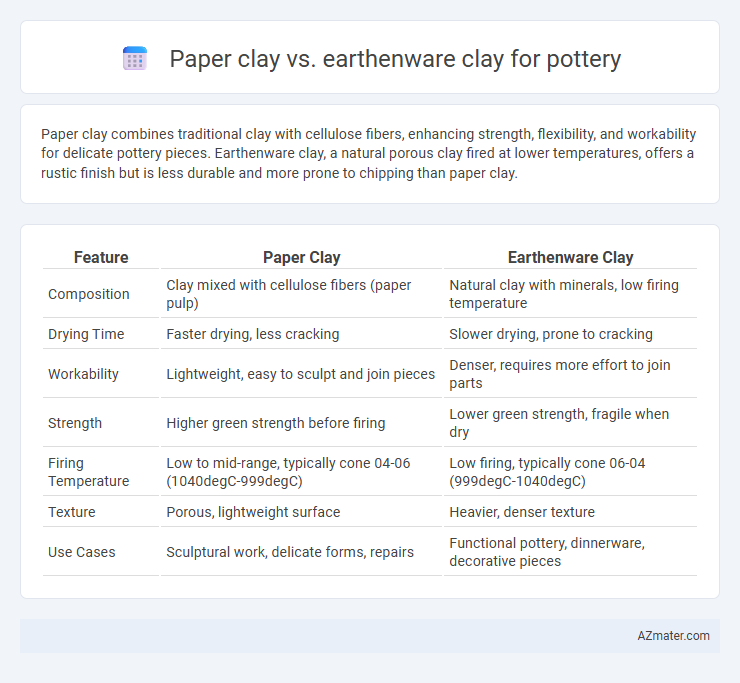Paper clay combines traditional clay with cellulose fibers, enhancing strength, flexibility, and workability for delicate pottery pieces. Earthenware clay, a natural porous clay fired at lower temperatures, offers a rustic finish but is less durable and more prone to chipping than paper clay.
Table of Comparison
| Feature | Paper Clay | Earthenware Clay |
|---|---|---|
| Composition | Clay mixed with cellulose fibers (paper pulp) | Natural clay with minerals, low firing temperature |
| Drying Time | Faster drying, less cracking | Slower drying, prone to cracking |
| Workability | Lightweight, easy to sculpt and join pieces | Denser, requires more effort to join parts |
| Strength | Higher green strength before firing | Lower green strength, fragile when dry |
| Firing Temperature | Low to mid-range, typically cone 04-06 (1040degC-999degC) | Low firing, typically cone 06-04 (999degC-1040degC) |
| Texture | Porous, lightweight surface | Heavier, denser texture |
| Use Cases | Sculptural work, delicate forms, repairs | Functional pottery, dinnerware, decorative pieces |
Introduction to Paper Clay and Earthenware Clay
Paper clay integrates cellulose fibers into traditional clay, enhancing its strength and flexibility during the drying stage, making it ideal for delicate or intricate pottery work. Earthenware clay, composed mainly of natural clay minerals and fired at lower temperatures (1,000 to 1,150degC), is porous and typically used for functional pottery like bowls and tiles. Understanding these fundamental differences helps potters choose the right material for their project based on durability, texture, and firing requirements.
What is Paper Clay?
Paper clay is a type of clay mixed with cellulose fiber, typically paper pulp, enhancing its strength and flexibility during the drying and firing process. Unlike traditional earthenware clay, paper clay allows for thinner, more delicate forms that are less prone to cracking and can be joined when dry. This unique composition makes paper clay ideal for intricate pottery designs and mixed-media art projects.
What is Earthenware Clay?
Earthenware clay is a natural, low-fire clay typically fired between 1,000degC and 1,150degC, known for its porous, soft texture and rich red, brown, or white colors. It contains high levels of iron and other impurities, which contribute to its characteristic warmth and rustic appearance in pottery. Unlike paper clay, earthenware is less flexible and more prone to cracking during drying but is favored for its ease of shaping and traditional aesthetic qualities.
Key Differences Between Paper Clay and Earthenware Clay
Paper clay contains cellulose fibers blended with traditional clay, enhancing its strength, flexibility, and drying time, making it ideal for delicate or complex pottery pieces. Earthenware clay is a natural, porous clay fired at lower temperatures, known for its rich, earthy colors but less durability compared to paper clay when dry. The primary differences lie in the fiber content, firing temperature range (typically 1,000 to 1,150 degC for earthenware), and surface texture, where paper clay offers smoother finishes and better green strength for assembly.
Workability and Handling Characteristics
Paper clay offers enhanced workability due to its lightweight texture and added fiber content, making it easier to shape and carve compared to traditional earthenware clay. Earthenware clay tends to be denser and more plastic, providing a tactile experience preferred for hand-building but requiring more skill to manage moisture levels. The fiber reinforcement in paper clay reduces cracking during drying and firing, improving handling characteristics especially for delicate or complex forms.
Drying Time and Shrinkage Rates
Paper clay dries significantly faster than earthenware clay due to its fiber content, which creates a porous structure that accelerates moisture evaporation. Earthenware clay typically exhibits higher shrinkage rates, approximately 5-12%, whereas paper clay's shrinkage is reduced to about 3-7%, minimizing cracking risks during drying. The lower shrinkage and quicker drying of paper clay make it ideal for intricate or delicate pottery requiring shorter production times.
Strength and Durability Comparison
Paper clay exhibits enhanced strength and durability due to its fiber content, which reduces cracking and increases resistance to impact compared to traditional earthenware clay. Earthenware clay, while more porous and less dense, tends to be more fragile and susceptible to chipping under stress. The fibrous reinforcement in paper clay allows for thinner, more delicate forms without compromising structural integrity, making it superior in strength for functional pottery.
Firing Temperatures and Glazing Options
Paper clay typically fires at lower temperatures, around cone 04 to cone 06 (about 1940degF to 2100degF), making it suitable for low-fire glazes that mature at these temperatures. Earthenware clay fires between cone 06 and cone 02 (about 1828degF to 2167degF), allowing a wider range of low-fire and mid-range glaze compatibility. Both clays offer diverse glazing options, but earthenware's higher firing range supports more durable, glossy finishes while paper clay's porous nature enhances texture and glaze adherence at lower temperatures.
Best Uses and Applications for Each Clay Type
Paper clay excels in creating lightweight, delicate pottery pieces due to its fiber-reinforced structure, making it ideal for intricate sculptures and thin-walled vessels that require extra strength during drying and firing. Earthenware clay, known for its porous nature and lower firing temperature, is best suited for functional wares like garden pots, tiles, and decorative items that benefit from its rustic finish and vibrant glaze absorption. While paper clay enhances workability and reduces cracking during drying, earthenware clay offers durability and traditional aesthetics favored in everyday pottery applications.
Choosing the Right Clay for Your Pottery Project
Paper clay offers enhanced flexibility and lighter weight due to its cellulose fiber content, making it ideal for delicate and intricate pottery projects that require added strength during drying. Earthenware clay, known for its porous nature and lower firing temperature range (typically 1,000-1,150degC), provides a traditional, earthy finish suitable for functional pottery like planters and containers. Selecting between paper clay and earthenware clay depends on your project's structural needs, desired texture, and firing capabilities, with paper clay excelling in sculptural work and earthenware favored for everyday pottery uses.

Infographic: Paper clay vs Earthenware clay for Pottery
 azmater.com
azmater.com